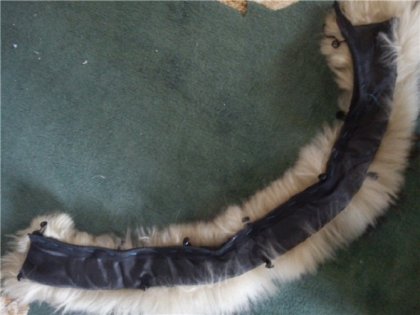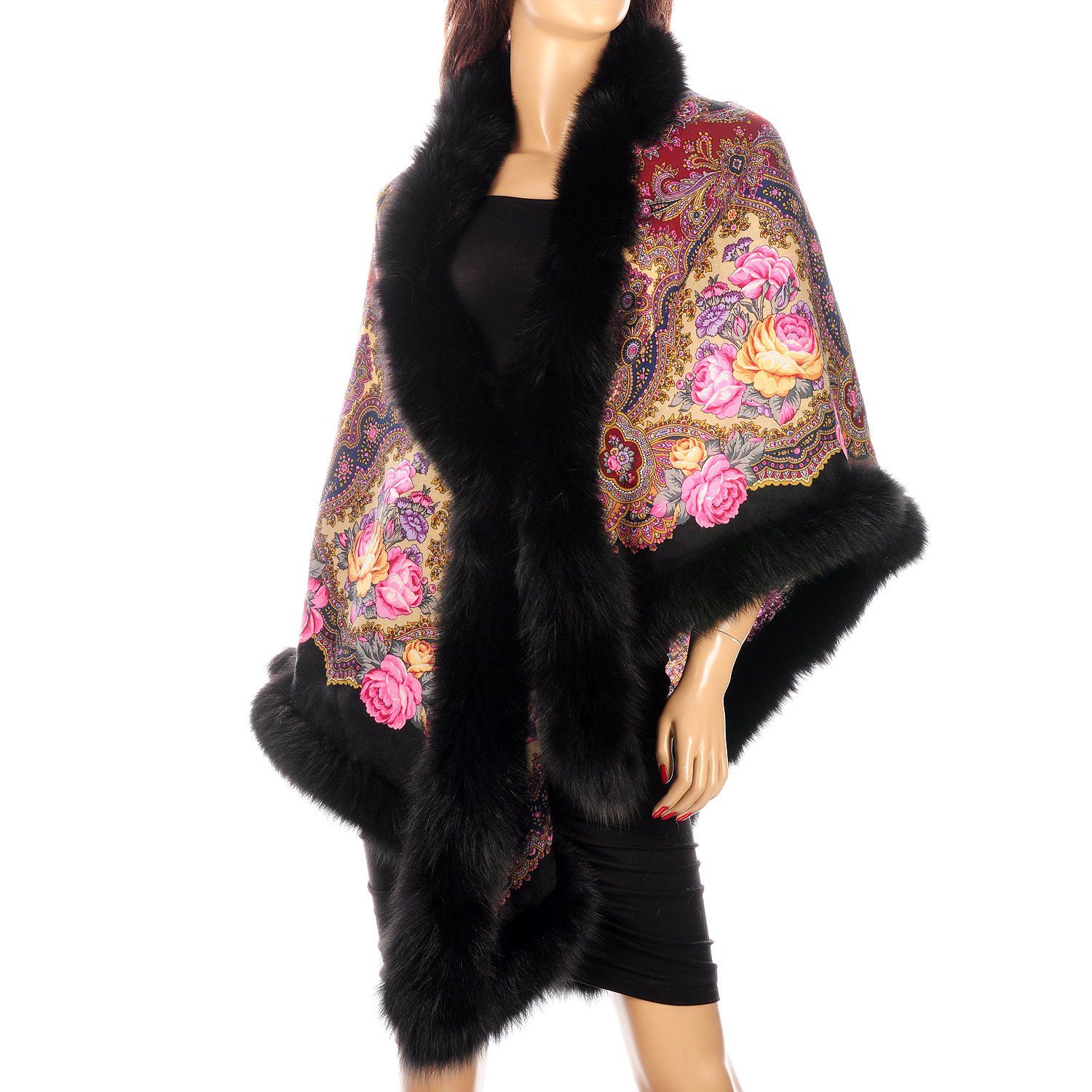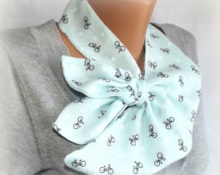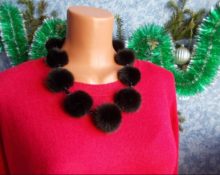 The fashion for headwear is changing rapidly, but there is a constant accessory that has gone through the entire history of mankind - the scarf and its variations.
The fashion for headwear is changing rapidly, but there is a constant accessory that has gone through the entire history of mankind - the scarf and its variations.
Headscarves, shawls, stoles, trimmed with different types of fur, will become real decorations of your wardrobe.
Definition of a headscarf, differences from a scarf
There are three main types of women's shawl-type headdresses:
- A scarf is the main option; it is square, not to be confused with a rectangular stole; as a rule, there is fringe at the edges. The fringe can be silk or wool.
- A shawl differs from a scarf in size (it is 1-5 centimeters larger), as well as in density. The shawl is denser and, accordingly, warmer. Pavlovo Posad shawls always have silk fringes.
- The scarf is triangular in shape, it’s like half a scarf. It is a right-angled equilateral triangle. Fringe is often missing.
Choosing fur
 The most popular type of scarves made of mink fur are scarves trimmed with fur.
The most popular type of scarves made of mink fur are scarves trimmed with fur.
It must be remembered that the color of the fur should repeat any color on the canvas.
What kind of skins could these be?
- Mink is the undisputed leader, often occupying large areas on the scarf.
- Arctic fox - used for edging, including circular.
- Red and silver fox are also sewn around the perimeter of the product.
- Sable.
- Raccoon.
- Rabbit.
Advantages of a headscarf and scarf over a hat
Let us examine in detail the advantages of sewing a headscarf with fur with your own hands. Why it makes sense to put aside your hat to wear this new thing:
- Scarves and shawls do not fit tightly to the head, do not crush the hair, and the hair follicles suffer less.
- Your hair will become less greasy and you will have to wash your hair less often.
- The scalp breathes.
- Scarves and scarves are perfect for a fur coat or an expensive coat.
Model options
There are three main ways to decorate with fur:
 Circular edge around the perimeter. These scarves are more comfortable to wear on the shoulders; tying them under the chin is inconvenient. Depending on the size, such a model can be an analogue of a boa, or a full replacement for a long-sleeved jacket.
Circular edge around the perimeter. These scarves are more comfortable to wear on the shoulders; tying them under the chin is inconvenient. Depending on the size, such a model can be an analogue of a boa, or a full replacement for a long-sleeved jacket.
 Fur trim around the face. Sewn from mink, sable, rabbit. Suitable as an addition to a fur coat with a hood.
Fur trim around the face. Sewn from mink, sable, rabbit. Suitable as an addition to a fur coat with a hood.
 Fur headscarf - the warmest option, covers almost the entire head, in winter it can replace a hat.
Fur headscarf - the warmest option, covers almost the entire head, in winter it can replace a hat.
We sew a scarf trimmed with fur around the perimeter
Required:
- Finished wool scarf or scarf, canvas size 145 x 145 cm.
- An arctic fox skin or several mink skins or old fur products.
- Threads to match the scarf or the leather part of the fur.
- Furrier's needles.
- Furrier's knife or razor blades.
 Progress:
Progress:
You need to cut the skin along the inside with a thin knife or razor.We use a plastic or metal backing, ignoring the wooden one, since wood particles will get stuck in the pile:
- We find all the abrasions of the fur, thin places of the flesh, and mark them with a ballpoint pen.
- We mark strips of the required width on the sandpaper; the length of all these strips should be equal to the perimeter of your product.
Advice! The direction of the pile must always be observed.
- We cut out our blanks.
- We remove the fringe from the scarf, simply cut it off carefully with scissors, grabbing about a centimeter of fabric.
- Fold our scarf in half and iron it well.
- Can be glued with double-sided interlining.
- We should have a double-sided canvas.
- We process the edges in a convenient way.
Important! If your fur is in pieces, sew them together before joining the fabric. In the same way, we first turn all the fragments of the edging into one large ribbon.
- We sew the resulting strips on our hands to the edge of the fabric with a seam across the edge. We straighten the fabric, stretch it, our seam should not gather.
- We don’t stretch the flesh.
- Sew the skin on all sides of the strip.
- You should be especially careful with the last fragment of fur.
We sew a fur bonnet
A scarf trimmed with fur only in the area near the face is called a hood.
Advice! A fur collar is suitable for this type of work; you don’t even need to rip it open.
 Required:
Required:
- Ready scarf or scarf.
- Any fur with low pile, preferably mink or sable.
- Fabric for lining - flap.
- Threads to match the scarf or the leather part of the skin.
- Furrier's needles.
- Furrier's knife or razor blades.
 Progress:
Progress:
- We prepare the skin for cutting, marking all the unsuccessful areas on the flesh.
- We cut out the required shape.
- For sewing, it is better to use fur with lining. Lining is fleece or scarf fabric.
- We cut out the lining details and sew them to the fur blank using a seam “over the edge”.
- If you have a ready-made collar with a lining - this is an ideal option.
- When trying it on, we mark on the scarf where the fur should be.
- We sew our lined fur design to the scarf.
 Let's try it on.
Let's try it on.
Caring for a fur scarf
So that this headdress will please you for more than one season, You need to remember a few rules of care:
- Do not wear such a headscarf in wet weather; not only rain, but also wet snow will damage it.
- Immediately when you return home, shake the fur thoroughly and remove any remaining snow or frost.
- Let it dry well and hang out.
- Comb dry fur with a brush.
- Store the scarf so that it does not wrinkle.
- If you have sewn a product from a real Pavlovo Posad scarf, then do not wash it, take it to the dry cleaner.
 Scarves, shawls, scarves with fur trim are not only warm, but also incredibly beautiful, and they are easy to make yourself.
Scarves, shawls, scarves with fur trim are not only warm, but also incredibly beautiful, and they are easy to make yourself.

 Almost every woman has mink and fox hats, which have gone out of fashion. Using them, you can create a completely new, up-to-date accessory.
Almost every woman has mink and fox hats, which have gone out of fashion. Using them, you can create a completely new, up-to-date accessory.


 Important! If your fur is in pieces, sew them together before joining the fabric. In the same way, we first turn all the fragments of the edging into one large ribbon.
Important! If your fur is in pieces, sew them together before joining the fabric. In the same way, we first turn all the fragments of the edging into one large ribbon. 0
0





